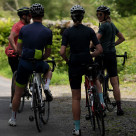Knowledge Level: Beginner
With modern clothing, there’s no reason not to be comfortable no matter how atrocious the conditions are. Follow our clothing guidelines to keep riding regardless of what the weather throws at you.
Cold
Skullcap: A close fitting hat that’s worn under your helmet. Look for windproof panels on the front, fleece lining if very cold and decent covering for your ears. I’ve you’ve got plenty of hair or tend to get a hot head, a headband that just covers your ears is a good alternative.
Sunglasses: On cold, clear and frosty days, the sun can necessitate dark sunglasses but usually, during the winter, you’ll swap in clear or light enhancing lenses. The glasses are there to keep the wind, rain and road spray out of your eyes.
Baselayer: Key to staying comfortable, a baselayer should be close fitting, wick sweat away from your skin and continue to insulate even when damp. Synthetics are okay but, for the best possible performance, it’s worth considering Merino wool.
Winter weight long sleeved jersey: A heavier weight cycling jersey with long sleeves and a slightly brushed or fleecy inside.
Waterproof jacket/Softshell jacket: Modern laminate materials combine full waterproofing with good breathability, keeping the rain out but ensuring you don’t boil in the bag and soak through with sweat. Look for an athletic fit, close seals around the collar and cuffs, a drawstring hem with a longer tail and some pockets. For cold and dry days, a softshell jacket will offer better breathability, more insulation and should also have a degree of water resistance in case of rain showers.
Gloves: Along with cold ears and feet, frozen and numb hands are guaranteed to make any ride a miserable experience. However you need to be able to operate your brakes and shifters so you can’t just wear thick mittens. Look for good wind or water resistance and some insulation. Ski gloves can be a good option if not too bulky and thin silk or Merino wool liners can make a real difference. Cycling specific gloves will also have some padding on the palms.
Bib tights: With shoulder straps to prevent slipping down, bib tights prevent your lower back from being exposed when you’re leaning forwards on the bike and provide an extra layer around your torso. Windproof panels on the front and fleecy “Roubaix” lining will keep you warm.
Socks: Don’t go too thick as you’ll make your shoes too tight, limit circulation and your feet will feel colder. Merino wool works brilliantly, isn’t too bulky and you can get waterproof and breathable socks that are lined with it and are particularly effective.
Overshoes/Winter booties: Neoprene overshoes fit over your regular cycling shoes providing protection against wind, rain and road spray and some insulation. They work well but can sometimes rub annoyingly on your cranks. For optimum foot warmth and comfort, a pair of dedicated waterproof and insulated winter cycling booties are the way to go.
Hot and sunny
Sunglasses: Not just for posing and looking cool but for keeping wind, grit and insects out of your eyes.
Suncream: Often forgotten in Britain but it’s all too easy to get sunburnt when you’re out on the bike for a long ride. Pay particular attention to the back of your neck as it’s especially exposed when cycling.
Vest/singlet: A thin vest under your jersey will wick sweat away and will help you stay cooler. String style vests are very effective and comfortable.
Short sleeved jersey: The cycling staple is the short sleeved jersey. Make sure it has got three decent sized rear pockets and a full length zip is great for making sure you keep cool on long climbs.
Track mitts: Protect your hands in a crash and, with padding on the palms, absorb road vibrations and help prevent hand numbness.
Bib shorts: Don’t worry about the “Mankini” look as the straps will be hidden under your jersey and, for comfort and not slipping down when you’re on the drops, they’re far superior to standard shorts. Spend the money on a quality brand as a decent pad is essential for long ride comfort.
Mixed day
Casquette: The traditional cotton cycling cap that’ll sit under your helmet giving some breathable protection against the wind and, with a peak, helping to keep rain out of your eyes. It’s also small enough to slip into your jersey pocket if the weather improves.
Sunglasses: As on cold days, use clear or light enhancing lenses. The latter are particularly useful on dull and overcast days for increasing object definition.
Baselayer: On mixed days you’ll ask much of your base layer as it’ll need to keep you comfortable through showers and across a wide range of temperatures. A lightweight short sleeved Merino t-shirt is your best bet.
Arm warmers: For cool starts or in-between days arm warmers are invaluable to cyclists. You can slip them on and off as the conditions and easily store them in your jersey pockets.
Gloves: It only takes a little wind and rain for your hands to get cold so, if you’re slightly unsure how the weather will pan out, opt for full fingered gloves. A fairly lightweight windproof pair will cover you in most conditions.
Race cape/gilet: Lightweight, breathable and small enough to be stashed away in a pocket, a full jacket or sleeveless gilet can provide the perfect amount of protection from an unexpected shower.
3/4 length bib shorts/knee warmers: An old adage among cyclist is that your knees should stay covered unless it’s warmer than 15 C. This may be taking things a bit far but, on mixed weather spring and autumnal rides, especially if you’ve got an early start, having your knees covered will make a difference. Knee warmers provide a flexible alternative to 3/4 length shorts.
Toe covers: You probably won’t want full overshoes or winter booties but lycra toe covers, which just slip over the fronts of your cycling shoes and block out the wind, are perfect for keeping your feet warm on mixed days.














